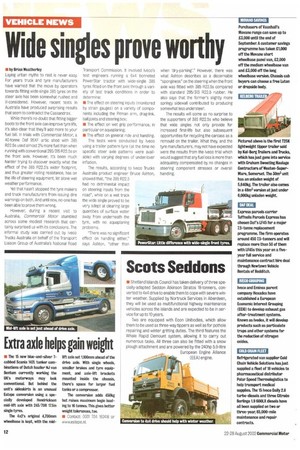Wide singles prove worth
Page 12

If you've noticed an error in this article please click here to report it so we can fix it.
• by Brian Weatherley Laying urban myths to rest is never easy. For years truck and tyre manufacturers have warned that the move by operators towards fitting wide-single 385 tyres on the steer axle has been somewhat rushed and ill-considered. However, recent tests in Australia have produced surprising results that seem to contradict the Cassandras.
While there's no doubt that fitting bigger boots to the front axle can improve tyre life, it's also clear that they'll add more to your fuel bill. In trials with Commercial Motor, a 40-tonne Daf 95XF artic shod with 385 R22.5s used almost 2% more fuel than when running with conventional 295/315 R22.5s on the front axle. However, it's been much harder trying to discover exactly what the effect of the 385 R22.5's wider footprint, and thus greater rolling resistance, has on the life of steering equipment, let alone wet weather performance.
Yet that hasn't stopped the tyre makers and truck manufacturers from issuing dire warnings on both. And until now, no-one has been able to prove them wrong.
However, during a recent visit to Australia, Commercial Motor stumbled across some modest research that certainly surprised us with its conclusions. The informal study was carried out by lveco Trucks Australia on behalf of the Transport Liaison Group of Australia's National Road Transport Commission. It involved lveco's test engineers running a 6x4 bonneted PowerStar tractor with wide-single 385 tyres fitted on the front axle through a variety of test track conditions in order to determine: • The effect on steering inputs (monitored by strain gauges) on a variety of components including the Pitman arm, drag-link, ball joints and steering box;
III The effect on wet grip performance, in particular on aquaplaning;
• The effect on general ride and handling.
The tests were conducted by lveco using a trailer pattern tyre (at the time no specific steer axle patterns were available) with varying degrees of under/over inflation.
The results, according to Iveco Trucks Australia product engineer Bruce Ashton, showed that, "the 385 R22.5 had no detrimental impact on steering inputs from the road", while on a wet track the wide single proved to be very adept at clearing large quantities of surface water away from underneath the tyre, with no aquaplaning problems.
"There was no significant effect on handling either," says Ashton, "other than when `dry-parking'." However, there was what Ashton describes as a discernable "sponginess" on the steering when the front axle was fitted with 385 R22.5s compared with standard 295/313 R22.5 rubber. He also says that the former's sightly more springy sidewall contributed to producing somewhat less understeer.
The results will come as no surprise to the supporters of 385 R22.5s who believe that wide singles not only provide for increased first-life but also subsequent opportunities for recycling the carcass as a remould on the trailer. What they, and the tyre manufacturers, may not have expected were the results from the lveco trial which would suggest that any fuel loss is more than adequately compensated by no changes in steering component stresses or overall handling.
















































































































































